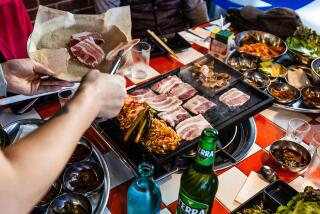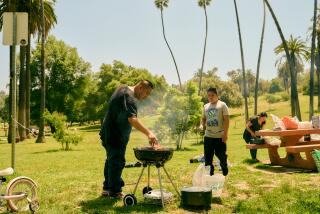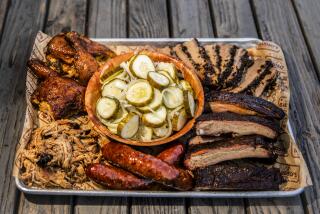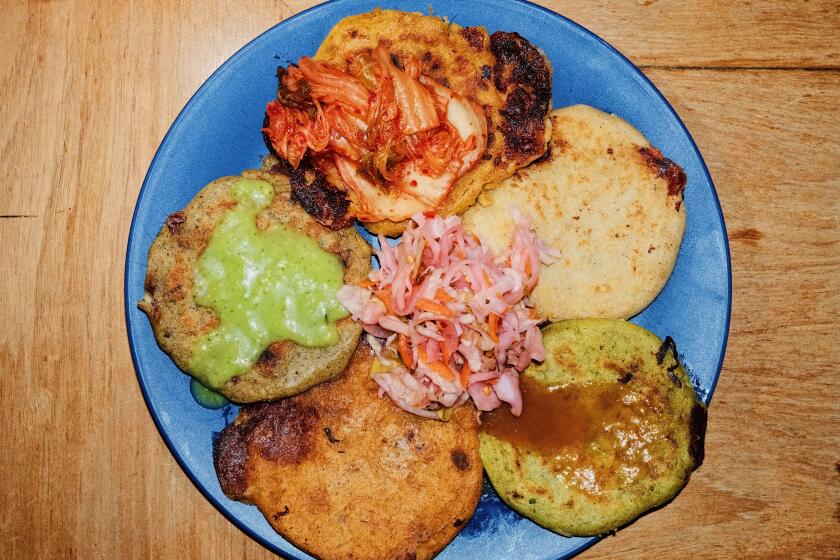Keep Home Barbecue Fires Burning
Just a few decades ago, firing up the family barbecue meant dragging out the Charm Glow from under its torn, vinyl cover, cleaning off the grill, adding the charcoal briquettes and squirting just the right amount of lighter fuel. (Use too much lighter fluid and you had a small bonfire raging.)
Fortunately for connoisseurs of barbecued delights, todayâs grills come with more efficient heating methods, safety features and accessories to make outdoor cooking much easier. There is also a wider selection of styles from which to choose.
Before buying a barbecue, consider how youâll be using it, says Tom Larson of Leisure Living Patio Furniture in La Habra. âMost people just want to cook hamburgers, hot dogs and chicken. If thatâs the case, they can choose a more simple model,â he says.
âHowever, if you want to cook turkeys, roasts or hams, youâre going to need a rotisserie,â he says. âWhen looking at the different models, you should have a pretty good idea of what youâll be cooking and what extra features youâll need.â
Gas grills--which are fueled by liquid propane that ignites the burners under the grill--outsell their charcoal counterparts, according to Larson. Among the benefits of gas grills are that they require less time to heat up (about 15 minutes), are easier to clean and the heat is evenly distributed, he says. With gas grills, you simply turn on the igniting switch and adjust the burner knobs, just like on a stove.
Gas grills are also environmentally sensitive, Larson says. âThe AQMD (Air Quality Management District) is encouraging people to buy gas grills because they burn cleaner than charcoal barbecues and donât require lighter fluid.â Through the end of year, the AQMD is offering rebates of $50 to $75 on many gas grills to encourage people to use them.
Gas grills do not compromise the taste, says Larson, âalthough some folks will claim they can tell the difference, the fact is the cooking system doesnât affect the taste.
âCharcoal is odorless and tasteless. You get the barbecue taste from the smoke and when the grease splatters up against the food,â he says. âWith the new gas grills, you have the same effects. With the popularity of wood chips, such as hickory or mesquite, the taste is wonderful.â
A smoker tray located below the grill can hold any variety of wood chips for a more distinctive flavor. While mesquite ranks as the most popular chip, followed by hickory, there are several varieties available including apple, cherry, oak, pecan and alder.
Gas grills come with different grill sizes from 300 to 410 square inches. Also available are smaller units with one burner or larger versions with dual burners or more. And there are portable gas grills that fit easily into the trunk of a car and can be hooked up to the RV gas line through a special adapter, eliminating the need for a propane tank.
âMost good gas grills come with a 5- to 15-year warranty so theyâre made to last,â Larson says. âWhat many customers donât realize is that you can purchase replacement parts if a burner or grill goes out . . . and if you barbecue frequently, you will need to replace them. Replacement parts are often still available even for models that are no longer manufactured.â
Larson says heâs seeing more people build gas grills into permanent brick counters to enhance the appearance of their yards. For convenience, they are adding a sink and counter space as well.
Smokers, according to Larson, have never achieved great popularity, probably because cooking with them requires a long wait.
âMost people want to throw a few steaks on a grill and have it ready pretty quickly,â he says. âWith a smoker, youâre looking at a preparation time of seven to eight hours. Theyâre kind of like a giant crock pot. Some people like them for smoked fish and turkey, but most folks want something that cooks a little faster.â
With the charcoal grills, the kettle grill is still popular (and generally costs less than gas grills). With the lid closed, the kettle grill functions much like an oven, and with the lid open, meats and vegetables can be cooked quickly on the grill.
When shopping for a grill, Larson offers some tips. For starters, he says donât purchase one with a front window.
âThe windows look nice on the showroom floor, but we receive at least one call a day from people who want to replace them,â he says. âThey break all the time and, unfortunately, canât be replaced. Even if you like the idea of being able to look in to see how the food is cooking, the window usually fogs up after the first use.â
When looking at the grills, select one with a thick lid and thick casting. âIf the metal feels thin, itâs not going to last,â he says. âShake the grill and see if it feels sturdy.â
Also determine whether you want shelves and if so, how many, he suggests. âSide shelves are nice because they give you a place to store your sauces or platters. However, some models have two shelves and you may not need that many. Shelves along the side seem preferable because theyâre easily accessible. If theyâre down below, theyâre harder to reach.â
Larson also recommends that shelves be made of durable metal instead of wood, which has a tendency to warp over time.
For the grill itself, avoid chrome, opting instead for stainless steel or porcelain-coated cast iron. âCast iron and stainless steel add to the durability of the unit,â Larson says. âAnd in California, where people have a tendency to barbecue year-round because of the warm weather, it makes sense to invest in a grill thatâs going to last a long time.â
Accessories for barbecuing have also undergone modifications through the years. Youâll still find long-handled spatulas, tongs and knives, as well as oven mitts and wire cleaning brushes, but the most popular accessories seem to be items that extend the use of a grill.
One is a holder that is designed so that fish or other foodstuff can be cooked on the top of the grill without falling through. The âwok grillâ is a curved pan that sits directly on the grill, allowing cooks to prepare vegetables or shrimp along with the meat or main dish.
Charcoal starters are hollow steel cylinders that you fill with charcoal briquettes and a few sheets of newspapers. Once lit, the briquettes heat up in about 15 minutes. Then the charcoal is emptied into the bottom of the barbecue.
More to Read
Eat your way across L.A.
Get our weekly Tasting Notes newsletter for reviews, news and more.
You may occasionally receive promotional content from the Los Angeles Times.








